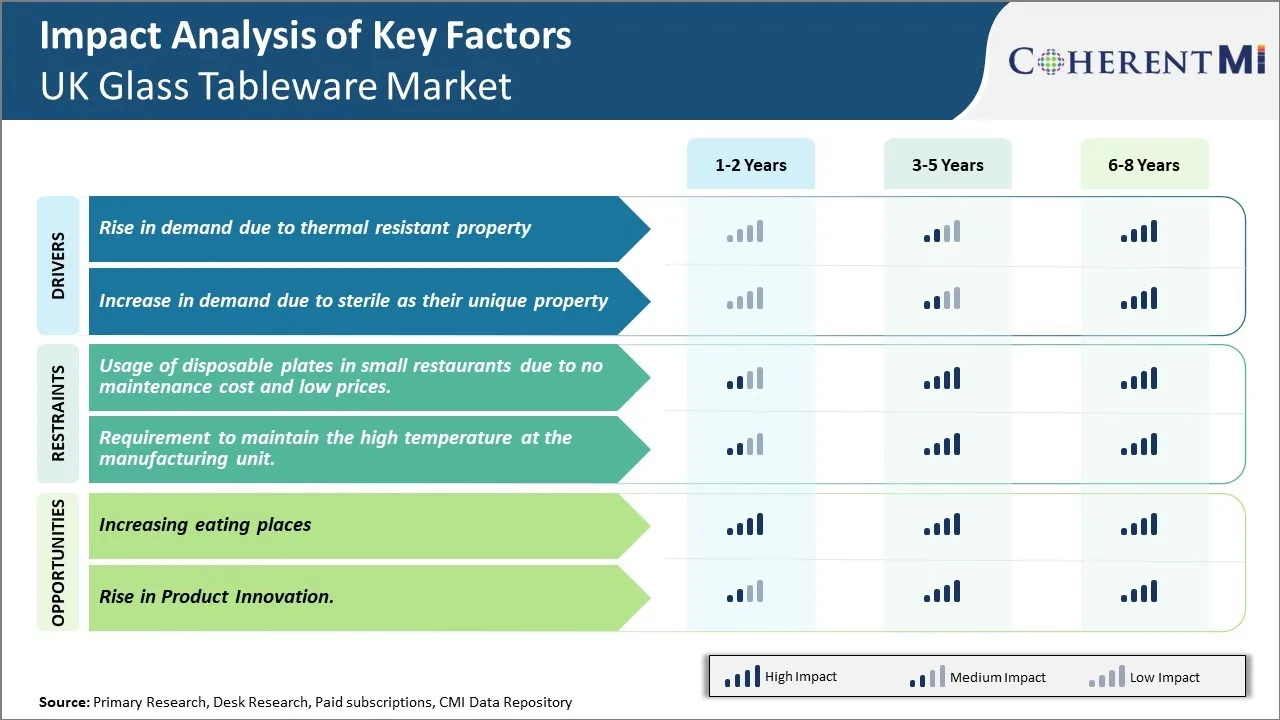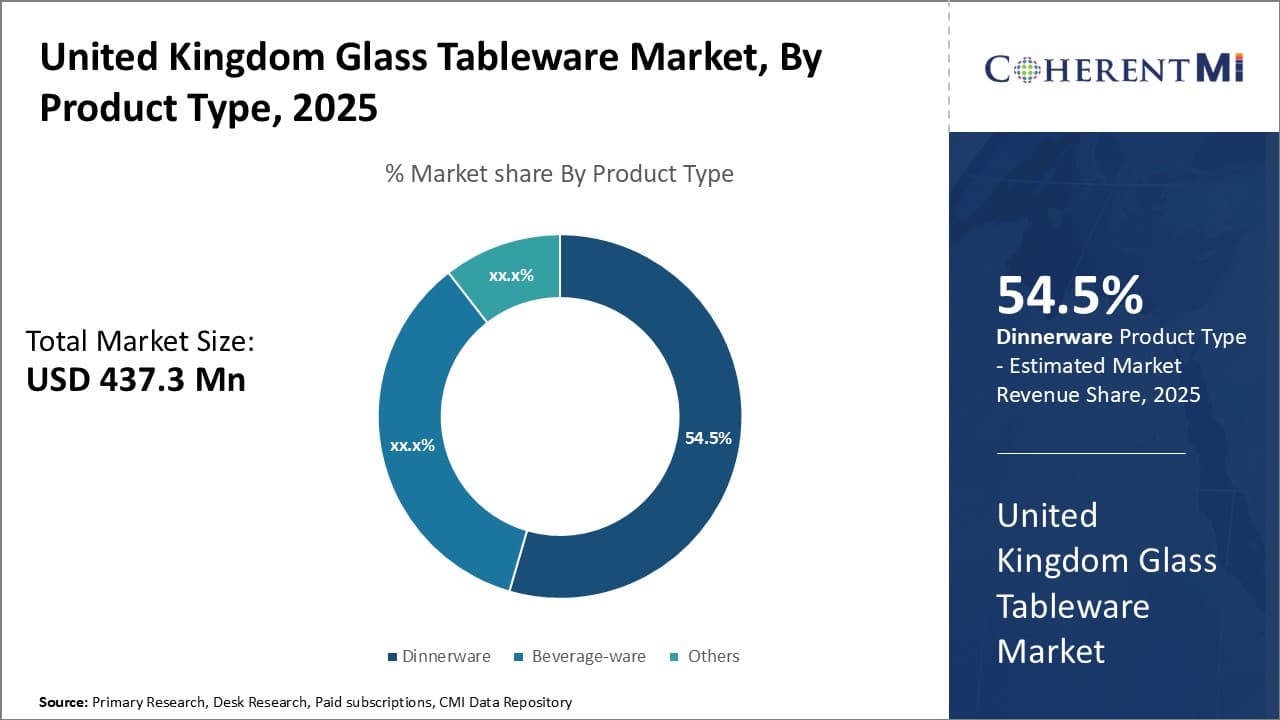

The United Kingdom Glass Tableware Market is estimated to be valued at USD 437.3 Mn in 2025 and is expected to reach USD 560.1 Mn by 2032, growing at a compound annual growth rate (CAGR) of 3.6% from 2025 to 2032.
The market has been witnessing a significant growth in the past few years due increased demand for glass tableware from hotels, restaurants and cafes.
Market Size in USD Mn
CAGR3.6%
| Study Period | 2025-2032 |
| Base Year of Estimation | 2024 |
| CAGR | 3.6% |
| Market Concentration | Medium |
| Major Players | Waterford Crystal, Wedgwood, Denby, Emma Bridgewater, Dartington Crystal and Among Others |
Market Driver – Rise in Demand Due to Thermal Resistant Property
The demand for thermally resistant glass tableware has been rising significantly in the United Kingdom market over the past few years. Thermal resistant glassware allows consumers to safely use hot pans, pots, or dishes directly on the table without the risk of cracking or breaking. This has provided convenience to households and led to increased usage of such products.
The sudden shift towards working from home amidst the pandemic has driven more home cooking activities and dining. Customers want tableware that can withstand the heat from freshly cooked food without safety concerns. The thermal resistant quality helps allow people to enjoy hot meals seamlessly without transferring dishes between the table and kitchen. This has streamlined the dining experience for many. Moreover, the rise in socially distanced gatherings and outdoor picnics has boosted the need for thermal shock resistant glass products that stay intact even when served hot food outdoors.
Sustainability has also become an important criterion for consumers worldwide. Glass is considered more eco-friendly than plastic or delicate ceramic tableware that produces sharps on breakage. Based on a 2020 survey by United Kingdom Environmental Protection Agency, 70% of British homes said they opt for glass over other materials for its longevity and recyclability. Thermal endurance further enhances the utility of glassware, reducing wastage. As environmental awareness increases, glass tableware with heat resistance will likely dominate the market.
Market Driver – Increase in Demand Due to Sterile as Their Unique Property
The unique property of glass being sterile is a major factor fueling demand for glass tableware in the United Kingdom. Glass does not support bacterial growth making it very hygienic. This property has become highly valued in the current health-conscious environment especially after the Covid-19 pandemic. As people focus more on home cooked meals and avoiding outside food due to virus risks, they prefer using glass containers and dishes that can be easily washed and sterilized using high temperatures. Furthermore, findings from United Kingdom government's Department for Environment, Food & Rural Affairs survey in 2021 suggest nearly 75% of British households are more inclined to choose sterile dishware for safety and hygiene.
The increasing health awareness has led to a major shift in preferences of consumers who now seek dishware that not just looks good but also keeps food safe. Glass being non-porous, no cracks or crevices for bacteria to hide in, makes it the ideal tableware material. The sterile nature offers an extra layer of assurance to families with kids and elders. This unique feature of preventing spread of illnesses through daily use items like plates and bowls is driving repeat purchases.
Market Challenge – Usage of Disposable Plates in Small Restaurants Due to No Maintenance Cost and Low Prices
The growing trend of using disposable plates in small restaurants is significantly restraining the growth of the United Kingdom glass tableware market. Disposable plates provide convenience to small restaurant owners as they do not require any maintenance. Glass tableware needs to be washed and maintained after every use to avoid breakage. This maintenance process is time consuming and labor intensive for small restaurants with limited staff resources. Additionally, running a full-scale dish washing operation also requires installation of dishwashers which further adds to initial setup and operational costs.
In contrast, disposable plates can simply be thrown away after use, eliminating all post dining cleaning efforts. This allows small restaurant owners to focus more on food preparation and customer service rather than backend operations. From a cost perspective as well, disposable plates work out much cheaper in the long run. The average cost of a glass plate is about 2-3 pounds whereas a set of 10 disposable plastic plates can be purchased for under 1 pound.
Adoption of disposable items is steadily growing across cafes and takeaway joints in United Kingdom high streets. As per United Kingdom Environmental Services Association, the consumption of plastic plates, cups and cutlery increased by 5% between 2020-2021 in England alone.
 To learn more about this report, Download Free Sample Copy
To learn more about this report, Download Free Sample Copy
Market Opportunity – Increasing Eating Places
The United Kingdom glass tableware market has strong potential to grow alongside the rise of eating places in the country. As socializing moves beyond homes to more restaurants and cafes, the demand for elegant and durable glass tableware from establishments is surging. Various industry reports suggest that the food services sector in the United Kingdom has been expanding in recent years and is expected to continue on an upward trajectory. For instance, the number of restaurants, cafes and bars in the United Kingdom increased from 144,363 in 2015 to 162,440 in 2020 according to data from the Office for National Statistics.
As more dining options open up, the requirements for glass tableware that can withstand commercial kitchen usage is increasing. Restaurant owners and managers need high-quality, aesthetically-pleasing items that can be reused extensively. Glassware fits this need perfectly with its hard, non-porous surface and versatility of styles.
The post-pandemic times are likely to further bolster this growth opportunity for glass tableware suppliers. With pandemic restrictions easing, people are becoming more comfortable with indoor dining and socializing in public places. This will drive higher demand at restaurants, cafes and pubs across the United Kingdom.
 To learn more about this report, Download Free Sample Copy
Insights, By Product Type: Beverage-ware Leads the United Kingdom Glass Tableware Market Thanks to Rising Cafe Culture
To learn more about this report, Download Free Sample Copy
Insights, By Product Type: Beverage-ware Leads the United Kingdom Glass Tableware Market Thanks to Rising Cafe Culture
Beverage-ware, which includes items such as glasses, mugs, and tumblers, accounts for the largest share of 54.5% in the United Kingdom glass tableware market. This is largely due to the growing cafe culture trend across the country. More and more Brits are embracing the coffee shop lifestyle and opting to work, socialize, or simply unwind in cafes. As people spend more time in cafes, the need for high-quality, durable beverageware has increased substantially.
Glass beverageware has proven highly popular with cafe owners seeking items that can withstand frequent washing and look stylish on tables. The see-through nature of glass also allows customers to clearly view the drinks inside. This adds to the perceived value and quality of what's being served. Additionally, glass is lightweight yet sturdy, making it easy for busy baristas to handle.
At home as well, glassware sets have found favor with consumers looking to recreate the cafe ambiance. Many now prefer sipping coffee or tea from elegant glass mugs and tumblers instead of traditional ceramic or plastic options. The rise of social media has amplified this trend, with influencers frequently posting pictures of artfully arranged glass drinkware.
 To learn more about this report, Download Free Sample Copy
To learn more about this report, Download Free Sample Copy
Insights, By Application Type: Commercial Sector Drives Overall Growth in the United Kingdom Glass Tableware Market
When analyzing the United Kingdom glass tableware market by application, it emerges that sales to the commercial sector comprise the highest share of 70.6%. Cafes, restaurants, pubs, event venues, and other foodservice establishments depend heavily on glass tableware to serve customers. Durable glass items allow establishments to handle high volumes of dishes through commercial dishwashers while maintaining an attractive presentation.
Hygiene is a major concern in the commercial food industry, and glass does not absorb odors or bacteria like ceramic and plastic can. Its see-through quality also enables servers to easily check that tables have been fully cleared away. With consumer demand for establishments high, glassware manufacturers have responded with an extensive selection of commercial glassware collections tailored for different cuisines and atmospheres.
While the stay-at-home trends of the pandemic hampered foodservice sales, the sector has shown strong signs of rebound as restrictions lift. Eateries have ramped up re-stocking of glass tableware after depletion during closures to welcome back diners. Commercial purchases are expected to rise further to support an extended outdoor dining season and future relaxation of regulations. The professional nature of glass also makes it a preferred option for event rentals and exhibitions.
The major players operating in the United Kingdom Glass Tableware Market include Masshine corp, Dartington Crystal, LSA International, Waterford Crystal, Georgia-Pacific, Royal Brierley, Emma Bridgewater, Denby, Portmeirion, and Wedgwood.
*Definition: Glass tableware is a product that is used to serve food for dining and other purposes as these form a part of table setting. These are produced from different materials such as glass, ceramics, and steel. Glass tableware products are generally classified into glass dinnerware, glass beverage-ware, and glass flatware.
Would you like to explore the option of buying individual sections of this report?
Sakshi Suryawanshi is a Research Consultant with 6 years of extensive experience in market research and consulting. She is proficient in market estimation, competitive analysis, and patent analysis. Sakshi excels in identifying market trends and evaluating competitive landscapes to provide actionable insights that drive strategic decision-making. Her expertise helps businesses navigate complex market dynamics and achieve their objectives effectively.
United Kingdom Glass Tableware Market is Segmented By Product Type (Dinnerware, Beverage-ware, Other...
United Kingdom Glass Tableware Market
How big is the United Kingdom Glass Tableware Market?
The United Kingdom Glass Tableware Market is estimated to be valued at USD 437.3 in 2025 and is expected to reach USD 560.1 Million by 2032.
What are the major factors driving the United Kingdom Glass Tableware Market growth?
The rise in demand due to thermal resistant property and increase in demand due to sterile as their unique property are the major factors driving the United Kingdom Glass Tableware Market.
Which is the leading product type in the United Kingdom Glass Tableware Market?
The leading product type segment is beverage-ware.
Which are the major players operating in the United Kingdom Glass Tableware Market?
Masshine corp, Dartington Crystal, LSA International, Waterford Crystal, Georgia-Pacific, Royal Brierley, Emma Bridgewater, Denby, Portmeirion, and Wedgwood are the major players.
What will be the CAGR of the United Kingdom Glass Tableware Market?
The CAGR of the United Kingdom Glass Tableware Market is projected to be 3.4% from 2025-2032.